new posts in all blogs
Viewing: Blog Posts Tagged with: 2016 reviews, Most Recent at Top [Help]
Results 26 - 33 of 33
How to use this Page
You are viewing the most recent posts tagged with the words: 2016 reviews in the JacketFlap blog reader. What is a tag? Think of a tag as a keyword or category label. Tags can both help you find posts on JacketFlap.com as well as provide an easy way for you to "remember" and classify posts for later recall. Try adding a tag yourself by clicking "Add a tag" below a post's header. Scroll down through the list of Recent Posts in the left column and click on a post title that sounds interesting. You can view all posts from a specific blog by clicking the Blog name in the right column, or you can click a 'More Posts from this Blog' link in any individual post.

By:
Betsy Bird,
on 3/30/2016
Blog:
A Fuse #8 Production
(
Login to Add to MyJacketFlap)
JacketFlap tags:
Reviews,
Best Books,
Carolrhoda Books,
multicultural children's literature,
Vaunda Micheaux Nelson,
multicultural picture books,
Lerner Publishing Group,
Elizabeth Zunon,
African-American books,
Best Books of 2016,
2016 picture books,
2016 reviews,
Reviews 2016,
Add a tag
 Don’t Call Me Grandma
Don’t Call Me Grandma
By Vaunda Micheaux Nelson
Illustrated by Elizabeth Zunon
Carolrhoda Books (a division of Lerner)
$19.99
ISBN: 978-1-4677-4208-5
Ages 4-7
On shelves now.
In 2016 a picture book won a Newbery Award. Which is to say, a picture book was declared the best-written work for children between the ages of 0-14. After its win there was a fair amount of speculation about what precisely the Newbery committee was trying to say with their award. For that matter, there was a fair amount of speculation about what it meant for children’s literature in general. Are we, as a people, less tolerant of loquacious books? Considering the fact that a book with 592 pages was a runner-up, I think we’re doing just fine in terms of wordy titles. Just the same, I hope that if anything comes out of this surprise award it’s a newfound appreciation for the picture book’s art of restraint. A good picture book shows but doesn’t tell. Don’t believe me? Read the original manuscript of Sendak’s Where the Wild Things Are where he spells everything out for the reader. All these thoughts were in my head recently when I read the remarkable Don’t Call Me Grandma by Vaunda Micheaux Nelson. Tackling the almost nonexistent subcategory of grouchy great-grandparents, Ms. Nelson deftly encapsulates a woman’s personality and lifetime of experiences in a scant 32 pages.
“Great-grandmother Nell is scary.” You got that right, kid. She also does not hug, or kiss, or chase her great-grandchild for fun. Instead she sips an intoxicating beverage from a glass bedecked with a spider. She serves up fish for breakfast, buggy eyes and all. But she also has a vanity full of mysterious perfumes, lipstick as red as rubies, and memories as sharp and painful as the day they were made. And when her great-granddaughter sneaks a kiss, Nell is still scary. But that’s okay. “…I like her that way.”
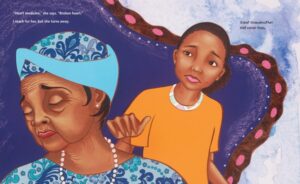 First and foremost, this is not a fuzzy grandparent (or great-grandparent) book. There are plenty of fuzzy books out there, filled to brimming with warm snuggly feelings. If that is the kind of book you require then grab yourself the nearest Nancy Tillman and content yourself accordingly. What we have here instead is a kind of character study. Whatever expectations you carry into this book, they will be upended by the text. Nell is an amazing character, one that I’ve never seen in book of this sort. Her prickly nature may well hide that “broken heart” she mentions obliquely, but it could just as easily hide more prickles. We get three distinct memories of her past, but it’s a single wordless two-page spread that probably says more about her than anything else. As an adult, I found myself speculating about her life. How perhaps she had dreams of dancing professionally but that she put those dreams aside when she had her children at a very young age. No kid is going to read into Nell what I have. That’s what makes reading this book so dynamic. Come for the prickly relative. Stay for the enticing, unknowable back story.
First and foremost, this is not a fuzzy grandparent (or great-grandparent) book. There are plenty of fuzzy books out there, filled to brimming with warm snuggly feelings. If that is the kind of book you require then grab yourself the nearest Nancy Tillman and content yourself accordingly. What we have here instead is a kind of character study. Whatever expectations you carry into this book, they will be upended by the text. Nell is an amazing character, one that I’ve never seen in book of this sort. Her prickly nature may well hide that “broken heart” she mentions obliquely, but it could just as easily hide more prickles. We get three distinct memories of her past, but it’s a single wordless two-page spread that probably says more about her than anything else. As an adult, I found myself speculating about her life. How perhaps she had dreams of dancing professionally but that she put those dreams aside when she had her children at a very young age. No kid is going to read into Nell what I have. That’s what makes reading this book so dynamic. Come for the prickly relative. Stay for the enticing, unknowable back story.
What I would really like to praise in this review, if nothing else, is just how deftly author Vaunda Micheaux Nelson parses words into sentences that swell with meaning. Take, for example, the moment when our heroine enters Great-Grandmother Nell’s bedroom. She considers playing with the cloth ballerina on the best but abstains, saying, “her expression makes me think she might tell.” Later she kisses her great-grandmother in her sleep. “Even asleep, Great-Grandmother Nell is scary. But I like her that way.” The very last line? “She won’t know”. It would be fascinating to see Nelson’s original manuscript. Was it just this sparse and spare? Or was it much longer and cut down to the bone in the editing process? Whichever it was, it works.
 The child in this book is much like the child who will be reading it with an adult. Both she and they sense that there is more at work here than meets the eye. And it is the art by Elizabeth Zunon that backs that feeling up. Elizabeth Zunon has been a force to reckon with for years. I first noticed her when she illustrated William Kamkwamba’s The Boy Who Harnessed the Wind, though I unknowingly had already been a fan of hers when she illustrated Jeanne Harvey’s My Hands Sing the Blues. In Don’t Call Me Grandma she begins with a straightforward contemporary story. Even then, her endpapers start telling the tale long before the words do (not counting the title). She fills these early pages with strings of pearls. Fat pearls, small pearls, pink and gray and white pearls. Note that in the text there is just one mention of those pearls, and it’s in the context of a lot of other things on Nell’s dressing table. But Zunon is getting a grip on her personality in her own way. Because of her we get a distinct sense of Great-Grandmother’s style, poise, and dignity. There are fun little details too, like the family peering out through the window as Nell gives a singing bird what for and how to. Zunon also lends Nell a humanity on the sidelines. When her great-granddaughter looks around her room we see Nell observing affectionately from the sides (though she’d be the first to deny it if you accosted her with the evidence). Then there are the memories. Depicted as splotchy watercolors, Zunon subtly changes her style to indicate how some memories are crystal clear even as they blur and go soft around the edges. The two-page spread of objects representing other memories (everything from photographs of Civil Rights marchers to tickets to an Alvin Ailey ballet) will require giving child readers some context. Nothing wrong with that. Sit them down and explain each thing you see. Don’t recognize something? Look it up!
The child in this book is much like the child who will be reading it with an adult. Both she and they sense that there is more at work here than meets the eye. And it is the art by Elizabeth Zunon that backs that feeling up. Elizabeth Zunon has been a force to reckon with for years. I first noticed her when she illustrated William Kamkwamba’s The Boy Who Harnessed the Wind, though I unknowingly had already been a fan of hers when she illustrated Jeanne Harvey’s My Hands Sing the Blues. In Don’t Call Me Grandma she begins with a straightforward contemporary story. Even then, her endpapers start telling the tale long before the words do (not counting the title). She fills these early pages with strings of pearls. Fat pearls, small pearls, pink and gray and white pearls. Note that in the text there is just one mention of those pearls, and it’s in the context of a lot of other things on Nell’s dressing table. But Zunon is getting a grip on her personality in her own way. Because of her we get a distinct sense of Great-Grandmother’s style, poise, and dignity. There are fun little details too, like the family peering out through the window as Nell gives a singing bird what for and how to. Zunon also lends Nell a humanity on the sidelines. When her great-granddaughter looks around her room we see Nell observing affectionately from the sides (though she’d be the first to deny it if you accosted her with the evidence). Then there are the memories. Depicted as splotchy watercolors, Zunon subtly changes her style to indicate how some memories are crystal clear even as they blur and go soft around the edges. The two-page spread of objects representing other memories (everything from photographs of Civil Rights marchers to tickets to an Alvin Ailey ballet) will require giving child readers some context. Nothing wrong with that. Sit them down and explain each thing you see. Don’t recognize something? Look it up!
A woman of my acquaintance used to make a big show of objecting to any and all picture books that depicted grandmothers as white-haired, doddering old women, tottering on the very edge of the grave. To her mind, there should be at least as many books that show those women as resourceful, spry, and full of energy. Great-Grandmothers probably have few books where they’re wrecking havoc with the universe. Generally speaking they just dodder and die. There will be no doddering and certainly no dying in Don’t Call Me Grandma, though. Nell isn’t just a character. She comes off the page like a full-blown human being, warts and all (just an expression – Nell would take me to the cleaners if she heard me indicating she has any warts). Sharp and smart, this is one of those picture books I’d like to see more of. Which is to say, stories I’ve never seen before.
On shelves now.
Source: Final copy sent from publisher for review.
Like This? Then Try:
Professional Reviews:


By:
Betsy Bird,
on 3/23/2016
Blog:
A Fuse #8 Production
(
Login to Add to MyJacketFlap)
JacketFlap tags:
Reviews,
poetry,
Roaring Brook,
Best Books,
macmillan,
Julie Morstad,
Neal Porter Books,
Julie Fogliano,
Best Books of 2016,
2016 reviews,
Reviews 2016,
2016 poetry,
2017 Newbery contenders,
Add a tag
 When Green Becomes Tomatoes: Poems for All Seasons
When Green Becomes Tomatoes: Poems for All Seasons
By Julie Fogliano
Illustrated by Julie Morstad
A Neal Porter Book / Roaring Brook Press (Macmillan)
$18.99
ISBN: 9781596438521
Ages 6 and up
On shelves now.
I don’t think I can adequately stress to you the degree to which I did not want to review this book. Not because it isn’t a magnificent title. And not because it isn’t pleasing to both eye and ear alike. No, it probably had more to do with the fact that it’s a work of poetry. I make a point of reviewing poetry regularly, though I’d be the first to say that it wasn’t my first language (if you know what I mean). I respect it but can occasionally find it tough going. I was determined to give this book its due, though. And the only way I could make myself physically sit down and review it was to read it cover to cover again. As I did so I was struck over and over, time and again, by just how melodious the language is here. Look, I’ll level with you. Seasonal poetry books are a dime a dozen. But what Fogliano and Morstad have created together is a lot more than just a book of poems for the changes of the year. This book manages to operate on a level that presents the very act of the seasonal cycle as positively philosophical, yet without distancing itself from its readership. It’s tricky territory, but together Fogliano and Morstad get the job done.
“from a snow-covered tree / one bird singing / each tweet poking / a tiny hole / through the edge of winter”. In the very first poem in When Green Becomes Tomatoes (a poem called “march 20”) the child reader is alerted to a change in the air. The snow is still present and the weather still gloomy, but there is hope on the horizon. Yet rather than turn the book into a paean to warmer weather, poet Julie Fogliano takes time to both celebrate and criticize the passing seasons. By the end of spring you look forward to summer and the end of summer leads to the relief of autumn, and so on and such. Accompanying these thoughts are small poems in lowercase and illustrations carrying the weight and expectations these seasons evoke in us. The end result can only be described in a single word: beautiful.
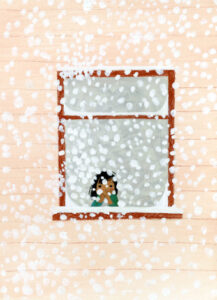 Like I said, I’ve read a lot of poetry books for kids about the seasons in my day. The good ones have some kind of a hook. Like Joyce Sidman tackling it with colors in Red Sings from Treetops or Jon J. Muth writing the poems entirely as haikus as in Hi, Koo! A Year in Seasons. But Fogliano doesn’t really have a hook, and so I approached the title with trepidation. No hook? You mean it was just going to be . . . poems?! It takes the courage of your convictions to do a poetry book for kids straight these days. And it’s not true that Fogliano didn’t have one ace up her sleeve. A lot of works of poetry start in January (when the year itself technically begins). Using a technique of highlighting random dates, this poet begins the book on March 20th, the first day of spring. A small hook, sure, but at least it’s something.
Like I said, I’ve read a lot of poetry books for kids about the seasons in my day. The good ones have some kind of a hook. Like Joyce Sidman tackling it with colors in Red Sings from Treetops or Jon J. Muth writing the poems entirely as haikus as in Hi, Koo! A Year in Seasons. But Fogliano doesn’t really have a hook, and so I approached the title with trepidation. No hook? You mean it was just going to be . . . poems?! It takes the courage of your convictions to do a poetry book for kids straight these days. And it’s not true that Fogliano didn’t have one ace up her sleeve. A lot of works of poetry start in January (when the year itself technically begins). Using a technique of highlighting random dates, this poet begins the book on March 20th, the first day of spring. A small hook, sure, but at least it’s something.
As for the poems themselves, I was impressed not just with the writing, but with Ms. Fogliano’s grasp of what each season actually entails. There are a LOT of cloudy days, rainy days, and generally blah days in this book. They don’t weigh down the narrative or really make it all that gloomy. You just end up experiencing precisely the same feeling you have when you’re living those days. This is the rare book that acknowledges that spring doesn’t immediately mean sunshine and 55-degree temperatures. There’s a lot of snow and some mud and a whole ton of rain. Listen to how she puts it, though: “today / the sky was too busy sulking to rain / and the sun was exhausted from trying / and everyone / it seemed / had decided / to wear their sadness / on the outside / and even the birds / and all their singing / sounded brokenhearted / inside of all that gray.” It really isn’t until June that things even out, and I respect that. All the seasons are like that. It’s great to watch.
As you might have noted, the poetry found in this book straddles a line between being child-friendly and introspective (the two aren’t mutually exclusive, but neither are they always natural pairs). I found myself noting line after line after line that I wanted to quote. Here’s a small taste for each season.
On Spring: “shivering and huddled close / the forever rushing daffodils / wished they had waited.”
On Summer: “if you ever stopped / to taste a blueberry / you would know / that it’s not really about the blue, at all.”
On Fall: “october please / get back in bed / your hands are cold / your nose is red / october please / go back to bed / your sneezing woke december.”
On Winter: “a gust of wind / blew by my nose / i think i will be frozen soon / this living room / (all cozy chairs and fireplace) / has some real explaining to do.”
Some books of children’s poetry lean heavily on the works of other poets. I won’t presume to name her influences but if the July 12th poem is any indication then William Carlos Williams might have had some influence here. And maybe e.e. cummings too (with all that mudlicious mud).
 When she was much younger it’s clear that author Julie Fogliano made some kind of a blood sacrifice to the God of Perfect Illustrator Pairings. How else to explain how she has managed to work alongside such artists as Erin E. Stead and now Julie Morstad? Morstad is no newbie to the field, of course. I’ve been a big fan of her for years, starting with her art for The Swing by Robert Louis Stevenson. Morstad’s great talent lies not necessarily in her waiflike black-eyed children, but rather in how she creates tone. Though there are plenty of sequences in this book of kids playing together or sharing food and soup, for the most part her characters go it alone. These poems are the contemplations of a young person with time and space and nature in spades. I don’t know that if I read Ms. Fogliano’s poetry without the art I would have picked up on that myself. Note too how cyclical the book is. The first poem is the last, sure as shooting, but so too is the person seen at both the beginning and the end. It’s the same kid wearing the same clothes, which makes a subtle implication that though a whole year has gone by, time is simply doubling back on itself. Not sure what to make of that one, frankly.
When she was much younger it’s clear that author Julie Fogliano made some kind of a blood sacrifice to the God of Perfect Illustrator Pairings. How else to explain how she has managed to work alongside such artists as Erin E. Stead and now Julie Morstad? Morstad is no newbie to the field, of course. I’ve been a big fan of her for years, starting with her art for The Swing by Robert Louis Stevenson. Morstad’s great talent lies not necessarily in her waiflike black-eyed children, but rather in how she creates tone. Though there are plenty of sequences in this book of kids playing together or sharing food and soup, for the most part her characters go it alone. These poems are the contemplations of a young person with time and space and nature in spades. I don’t know that if I read Ms. Fogliano’s poetry without the art I would have picked up on that myself. Note too how cyclical the book is. The first poem is the last, sure as shooting, but so too is the person seen at both the beginning and the end. It’s the same kid wearing the same clothes, which makes a subtle implication that though a whole year has gone by, time is simply doubling back on itself. Not sure what to make of that one, frankly.
With poetry, we have to play the game of answering what ages we think the poems are appropriate for. This book poses a bit of a challenge on that front. Some are younger, some definitely older. This mix will allow kids of all ages to take part in the fun, even as the book asks questions like whether or not there is a space between where things begin and things end “or just a slow and gentle fading”. Enticing to the eye but, more importantly almost, alluring to the brain as kids parse what Fogliano is trying to say, this is a book that has the potential (with the right teacher or parent) to convert the formerly unconvertible to the wonders of poetry itself. The truth of the matter is this: Fogliano and Morstad will make poets of us all.
On shelves now.
Source: Galley sent from publisher for review.
Like This? Then Try:
Professional Reviews:
Other Reviews:


By:
Betsy Bird,
on 3/1/2016
Blog:
A Fuse #8 Production
(
Login to Add to MyJacketFlap)
JacketFlap tags:
Reviews,
picture books,
Simon and Schuster,
Atheneum,
Best Books,
Evan Turk,
Best Books of 2016,
2016 picture books,
2016 reviews,
Reviews 2016,
original folktale,
Add a tag
 The Storyteller
The Storyteller
By Evan Turk
Atheneum (an imprint of Simon & Schuster)
$24.99
ISBN: 9781481435185
Ages 4-8
On shelves June 28th
Credit the internet age for doing what the television age never could. I don’t know if you’ve noticed, but there is a movement around the world that can be interpreted as nothing so much as a direct response to our digital age. You may have noticed it in small things, like the rise of Steampunk or the sudden surge of interest in Maker stations and the kinds of “hacking” that look suspiciously similar to activities found in shop class in days of yore. All this comes about because people have come to believe that we do not create enough tangible objects in our day-to-day lives anymore. And while this is true, let us not forget that we do not create enough intangible objects either. I’m talking about storytelling, that ancient artform that is currently seeing a worldwide resurgence. It isn’t just the increase in storytelling festivals and podcasts like The Moth here in the States. Young people in countries worldwide are doing what their elders have desired for decades; they’re asking to be told a story. Taking his cues from the newfound interest of young Moroccans in Marrakech in the ancient storytelling tradition, author/illustrator Evan Turk uses the folktale format to craft an original story about storytelling, weaving, history, and language. The end result is a twisty turny story within a story within a story that challenges young readers even as it lures them in.
Once, in the great country of Morocco, storytellers flourished and the cities’ fountains flowed with cool, clear water. As time went on the people became comfortable and forgot about the storytellers, and so they disappeared over the years. So too did the fountains dry up, until one day a boy went looking for some water. What he found instead was an old storyteller. As the man told his tale he would end his story with a story within a story and the boy would find his brass cup filled with liquid. Even as this was happening, however, a desert djinn saw the drought as an opportunity to reclaim the cities that had previously held him back with their fountains. Yet when the djinn was set to level his town, the boy managed to delay him with his storytelling. And as he wove his tale, the people were able to refill their fountains until finally storytelling and water ran freely in the cities once more.
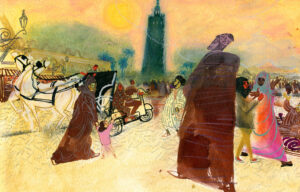 My brain is not what it used to be. Remind me again. What’s that term for a story that tells a story that tells a story that ends only when the innermost story doubles back and each tale is finished in turn? Is there a word such a thing? I suspect that the storytellers amongst us would know. The most obvious similarity to this book that comes to mind is, of course, the tale of Scheherazade. Indeed, the boy uses his stories to trick the djinn. And what could be a more natural comparison? In both tales it is storytelling that proves to be the saving of us all. Our thirst is quenched and we are tied to our history like never before. The obvious question then is whether or not Turk’s text is too complex for kids to follow. Sure, he distinguishes between the tales with different colored fonts, but will that be enough to allow them to remember what came before as they plunge deeper and deeper into the narrative? I think there may be some confusion at work, certainly. I wouldn’t necessarily hand this to a three or four-year-old. However, Turk’s text takes pains to remind the reader where the tale was before. The art helps as well. Confusion, such as it is, will be held to a minimum.
My brain is not what it used to be. Remind me again. What’s that term for a story that tells a story that tells a story that ends only when the innermost story doubles back and each tale is finished in turn? Is there a word such a thing? I suspect that the storytellers amongst us would know. The most obvious similarity to this book that comes to mind is, of course, the tale of Scheherazade. Indeed, the boy uses his stories to trick the djinn. And what could be a more natural comparison? In both tales it is storytelling that proves to be the saving of us all. Our thirst is quenched and we are tied to our history like never before. The obvious question then is whether or not Turk’s text is too complex for kids to follow. Sure, he distinguishes between the tales with different colored fonts, but will that be enough to allow them to remember what came before as they plunge deeper and deeper into the narrative? I think there may be some confusion at work, certainly. I wouldn’t necessarily hand this to a three or four-year-old. However, Turk’s text takes pains to remind the reader where the tale was before. The art helps as well. Confusion, such as it is, will be held to a minimum.
I first knew of Turk’s work when he illustrated Bethany Hegedus’s Grandfather Gandhi. In that book he integrated real spun cotton threads into the art, knowing full well the importance spinning had to Gandhi and his followers. In this book, weaving is the craft of choice so I wondered, not without reason, if woven threads would make their way into the art. As it happens, there are plenty of water-soluble crayons, colored drawing pencils, inks, indigo, sugared green tea, and even art created by heat gun and fire in the illustrations, but nothing so simple as thread. Turk mentions this on his publication page and he puts a little note to the reader there as well. It reads, “Look for a blue glimmer of hope to appear around each story!” and a small blue diamond appears. Naturally, I was curious so I looked. Sure as shooting, after each story’s text a diamond appears. However, as the stories appear within stories within stories, the diamonds grow more elaborate and decorative. Then, as the stories end one by one, the diamonds simplify once more. I began searching the art for more diamonds and here Turk doesn’t disappoint. If you look closely at the borders of the book, you see that the diamonds appear when there is hope and fade from blue to brown diamonds when hope dries up. As the storytelling increases the borders fill in more and more blue, just as the townspeople fill their fountains with bowl after bowl of water. Point out to a child reader the diamond motif and you are sure to be surprised by all that they find hidden in these pages.
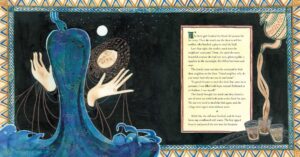 I should probably say something about Turk’s art itself. When I reviewed Grandfather Gandhi I had difficulty putting into words precisely what Turk does with his images. So I looked at the book’s professional reviews. His art causes reviewers to use terms like “dynamic visuals”, “stylized” and “strikingly patterned”. They say his art displays “bold, expressive imagery” or that he “mixes carefully detailed renderings with abstracted expressions of emotional struggle.” I agree with all of that but no one mentions his faces and hands. The patterns here are striking and upon closer inspection they yield such marvelous details it wouldn’t take much for this art to spin wildly out of control, opting for an abstract approach to the proceedings as a whole. Instead, Turk centers his art through the hands and faces of his characters. Look closely and you’ll see what I mean. The old storyteller’s hands are gnarled and wonderfully expressive, even as his audience of one clutches a single brass bowl. The hands of a cunning neighbor stroke her child as she schemes, while a princess, escaping on the night before her wedding, holds up her hennaed hands in despair. Hands. Heads. Hearts.
I should probably say something about Turk’s art itself. When I reviewed Grandfather Gandhi I had difficulty putting into words precisely what Turk does with his images. So I looked at the book’s professional reviews. His art causes reviewers to use terms like “dynamic visuals”, “stylized” and “strikingly patterned”. They say his art displays “bold, expressive imagery” or that he “mixes carefully detailed renderings with abstracted expressions of emotional struggle.” I agree with all of that but no one mentions his faces and hands. The patterns here are striking and upon closer inspection they yield such marvelous details it wouldn’t take much for this art to spin wildly out of control, opting for an abstract approach to the proceedings as a whole. Instead, Turk centers his art through the hands and faces of his characters. Look closely and you’ll see what I mean. The old storyteller’s hands are gnarled and wonderfully expressive, even as his audience of one clutches a single brass bowl. The hands of a cunning neighbor stroke her child as she schemes, while a princess, escaping on the night before her wedding, holds up her hennaed hands in despair. Hands. Heads. Hearts.
There’s been a lot of discussion lately about diversity in children’s literature. Specifically, some of that discussion has concerned those books written by white people about other cultures. It’s not a new phenomenon but what is a bit new is the increasing understanding that if you are going to use another culture, you need to do your homework. If, for example, you are setting a story in Morocco, then you need to make the readers understand why you made that choice. That it wasn’t arbitrary. This is yet another of the many reasons I’m so impressed with Turk’s work here. That he sets his story in Morocco (contemporary Morocco, by the look of it) is deeply purposeful. The Author’s Note at the end explains further. From this we learn that Morocco’s public storytellers or hlaykia have told tales for “nearly one thousand years” and yet “Only a handful of master storytellers remain”. All is not lost, though. Renewed interest in storytelling has surfaced, specifically at a restaurant called Café Clock in Marrakech. Turk then closes with a small Bibliography of sources on everything from storytelling to carpet weaving. The book then is not an appropriation of an “exotic” culture done on a whim but rather a considered, thoughtful selection that serves as an ideal setting for a tale about storytelling then, now, and in the future.
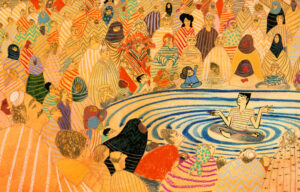 It was once part of a children’s librarian’s training to know how to tell a story from memory. Here in America it was even considered part of a children’s librarian’s heritage, though in the last few decades it has been fast forgotten. There are still pockets that remember, though. That’s why books like Turk’s give me the oddest little sense of hope. As I mentioned before, storytelling everywhere is seeing renewed interest. It seems odd to say, but this book, wrapped as it is in classic motifs and themes dating back hundreds, even thousands, of years, is one of the freshest, most timely picture books I’ve had the honor to read in a long time. Visually stunning with a storyline to match, Turk is beginning to make good on his talents. This is a man with storytelling in his blood and bones. Our children reap the rewards. A can’t miss book.
It was once part of a children’s librarian’s training to know how to tell a story from memory. Here in America it was even considered part of a children’s librarian’s heritage, though in the last few decades it has been fast forgotten. There are still pockets that remember, though. That’s why books like Turk’s give me the oddest little sense of hope. As I mentioned before, storytelling everywhere is seeing renewed interest. It seems odd to say, but this book, wrapped as it is in classic motifs and themes dating back hundreds, even thousands, of years, is one of the freshest, most timely picture books I’ve had the honor to read in a long time. Visually stunning with a storyline to match, Turk is beginning to make good on his talents. This is a man with storytelling in his blood and bones. Our children reap the rewards. A can’t miss book.
On shelves June 28th.
Source: F&G sent from publisher for review.
Like This? Then Try:
- Frederick by Leo Lionni
- Tell Me the Day Backwards by Albert Lamb, ill. David McPhail
- The Girl Who Saved Yesterday by Julius Lester, ill. Carl Angel
Misc:
See more images from the book here.


By:
Betsy Bird,
on 2/25/2016
Blog:
A Fuse #8 Production
(
Login to Add to MyJacketFlap)
JacketFlap tags:
Reviews,
Lee & Low Books,
nonfiction picture books,
Best Books,
alphabet books,
Lulu Delacre,
Best Books of 2016,
2016 reviews,
Reviews 2016,
2016 nonfiction picture books,
Add a tag
 ¡Olinguito, de la A a la Z! / Olinguito, from A to Z
¡Olinguito, de la A a la Z! / Olinguito, from A to Z
By Lulu Delacre
Children’s Book Press, an imprint of Lee & Low Books
$18.95
ISBN: 978-0-89239-327-5
Ages 4-7
On shelves now
Adults, I have a little secret. Have you ever wanted to sound smart at dinner parties? Knowledgeable in the ways of the world and how it works? It’s easy to do if you know the secret. Come closer… I’ll whisper it to you. Read nonfiction children’s books. Seriously, do that and watch as your brain expands. If I can talk with any competency about the Donner Party or the siege of Leningrad or the Pentagon Papers, it is because I read nonfiction written for people half my age and younger. Most recently I learned about olinguitos. Ever heard of them? If not, you aren’t alone. These shy little rainforest denizens were only discovered and announced as recently as 2013. Not too much is known about them, which makes placing them into picture books a bit of a challenge. Author/illustrator Lulu Delacre had a plan, though. All she’d need to do would be to turn the story of the discovery of olinguitos into a bilingual/alphabet/nonfiction/search & find title. You see? Easy peasy. Or, put another way, so incredibly difficult that no one else would have ever attempted it. But that’s what I like about Ms. Delacre. Sometimes the craziest ideas churn out the most interesting books.
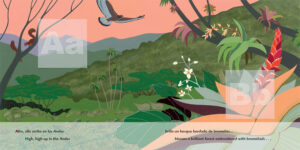 A zoologist from Washington D.C. is in the cloud forest today. He is searching for the elusive olinguito, a squirrel-like mammal that dwells in the trees. Along his path we meet the rainforest in an abecedarian fashion. From the A for the Andes to the M of moss and monkey, finally ending with Z for the zoologist himself, the book observes the many denizens that call the cloud forest their home. The book is entirely bilingual and backmatter (also bilingual) consists of notes on the “Discovery of the Olinguito”, facts about the Cloud Forest, information about the illustrations, hints on how to be an explorer, a heavily illustrated Glossary, “More Helpful Words”, and an extensive list of Author’s Sources.
A zoologist from Washington D.C. is in the cloud forest today. He is searching for the elusive olinguito, a squirrel-like mammal that dwells in the trees. Along his path we meet the rainforest in an abecedarian fashion. From the A for the Andes to the M of moss and monkey, finally ending with Z for the zoologist himself, the book observes the many denizens that call the cloud forest their home. The book is entirely bilingual and backmatter (also bilingual) consists of notes on the “Discovery of the Olinguito”, facts about the Cloud Forest, information about the illustrations, hints on how to be an explorer, a heavily illustrated Glossary, “More Helpful Words”, and an extensive list of Author’s Sources.
I’ve read plenty of Spanish bilingual picture books in my day. In doing so, I’m a bit handicapped since I don’t speak the language. Still, there are things that I can observe from my end. For example, the difficulty Ms. Delacre must have faced in writing two texts, both of which had to contain specific letters of the alphabet. Now the primary language in this book, to a certain extent, is the Spanish. For each letter the Spanish sections get a lot more use than the English. Take the letter “J”. In the Spanish language section it reads, “Jigua jaguey y jazmin brotan, crecen en tal jardin.” Pretty straightforward. Now in the English: “Jigua, fig, and coffee trees sprout and grow in this garden.” Were it not for the “jingua” we’d be out a J. To be fair, sometimes the two languages get equal use of a letter. “I”, for example, is “insectos incredibles y una inerte iguana” and also “incredible insects, and a resting iguana.” However, more often than not the Spanish gets more words with the chosen letter. This is particularly true near the end of the book where the English translations at times completely do away with the letter at all. In “X” and “U” (surprisingly) not a single word in the English portions begin with those letters. What is clear is that the Spanish is the focus of the book. With that in mind, the book acquires another potential use; excellent reading for people learning Spanish.
 It’s been a long time since I reviewed a Lulu Delacre book. I think the last time I seriously considered one was when Ms. Delacre illustrated Lucia Gonzalez’s The Storyteller’s Candle. There, the book integrated newspapers and other mixed media to tell the tale of two children introducing their immigrant neighborhood to the library. Here, the art is also mixed media but there’s a smoothness to it that was lacking in Storyteller’s Candle. In the back of the book Ms. Delacre mentions that there are real pressed leaves and flowers in every picture (something I entirely missed on my first, second, and third reads). There is also a zoologist in every picture, like a fuzzy little olinguito-seeking Waldo. Add in the colors, angles, and gorgeous spreads and you’ve got yourself one heck of a colorful outing. Ms. Delacre even mentions in her note at the book’s end that, just to be honest, these pictures are entirely too clear. “I decided to remove the clouds and limit the vegetation. I represented the fog and mist with squares of translucent paper framing the alphabetic letters. This allowed the species to be in plain sight.” Not only is she honest but creative as well.
It’s been a long time since I reviewed a Lulu Delacre book. I think the last time I seriously considered one was when Ms. Delacre illustrated Lucia Gonzalez’s The Storyteller’s Candle. There, the book integrated newspapers and other mixed media to tell the tale of two children introducing their immigrant neighborhood to the library. Here, the art is also mixed media but there’s a smoothness to it that was lacking in Storyteller’s Candle. In the back of the book Ms. Delacre mentions that there are real pressed leaves and flowers in every picture (something I entirely missed on my first, second, and third reads). There is also a zoologist in every picture, like a fuzzy little olinguito-seeking Waldo. Add in the colors, angles, and gorgeous spreads and you’ve got yourself one heck of a colorful outing. Ms. Delacre even mentions in her note at the book’s end that, just to be honest, these pictures are entirely too clear. “I decided to remove the clouds and limit the vegetation. I represented the fog and mist with squares of translucent paper framing the alphabetic letters. This allowed the species to be in plain sight.” Not only is she honest but creative as well.
I’ll level with you that I’m not entirely certain how one goes about using this book with kids. That is not to say that I don’t think it can be done and done well. But what Ms. Delacre has conjured up here isn’t a simple book. It’s not simplistic. The English text lacks much of the fun alliteration of the Spanish, which means the teacher or parent who reads this with their non-Spanish speaking children will need to span that gap themselves. It’s not a readaloud in the sense that you can just read it to a group without comment. This is an interactive text. You need to be spotting the zoologist, naming the vegetation and animals, flipping back and forth between the pictures and the glossary for clarification on different names, etc. In other words, this book requires the adult reader to be an active rather than passive participant in the reading process. Olinguito is more than mere words on a page.
There’s a soft spot in my heart for any book that proves to kids that there is more out there to find and discover than they might expect. The oceans haven’t been mapped out. Outer space remains, in many ways, a mystery. And hidden in the rainforests are tiny creatures just waiting to be discovered. Our world still needs explorers. If it takes one tiny mammal to prove that to them, so be it. A clever, lovely, wise little book. Knowledge of Spanish helpful, but not required.
On shelves now.
Like This? Then Try:
Professional Reviews:


By:
Betsy Bird,
on 2/21/2016
Blog:
A Fuse #8 Production
(
Login to Add to MyJacketFlap)
JacketFlap tags:
Reviews,
middle grade fiction,
fantasy,
middle grade fantasy,
funny books,
Alfred A. Knopf,
Random Penguin House,
Susan Hill Long,
funny fantasy,
2016 reviews,
Reviews 2016,
2016 middle grade fantasy,
2016 middle grade fiction,
Add a tag
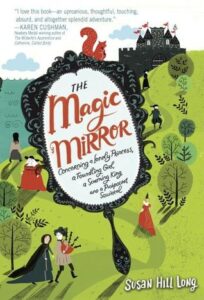 The Magic Mirror: Concerning a Lonely Princess, a Foundling Girl, a Scheming King, and a Pickpocket Squirrel
The Magic Mirror: Concerning a Lonely Princess, a Foundling Girl, a Scheming King, and a Pickpocket Squirrel
By Susan Hill Long
Knopf (an imprint of Penguin Random House)
$16.99
ISBN: 978-0-553-51134-2
Ages 9-12
On shelves May 10th
What do you want from a fairy tale? Magic? Romance? Derring-do? Despicable villainy? Academics and scholars have puzzled and puzzed until their puzzlers were sore over what it is about the European fairy tale genre that so enthralls us. Recently fairy tale lovers have seen the entertainment industry discover that fairy tales are still a primo source of capital. On the book side of things, I’ve seen a distinct uptick in retellings of Cinderella, Little Red Riding Hood, and more in the last five years. Classic fairy tales have it easy. It’s the newbies that have a hard time going. How do you get a foothold in a genre that’s been in existence for centuries? In The Magic Mirror by Susan Hill Long, the author decides to simplify. Merely take the elements that suit the story best (highway robbers, princesses, and just a smidgen of magic) and then weave in some surprisingly stellar writing. The result is fairy tale fare that reminds one of nothing so much as the best of Gail Carson Levine. Funny, friendly, witty and sly, this makes for perfect bedtime reading.
Margaret (or Maggot, depending on who’s talking about her) should technically be grateful for her life. Though she sports a lame foot (an “accident of birth” she’s been told) and is an orphan, she has a roof over her head, food in her belly, and aside from avoiding Thomas, the local bully, not too much trouble in life. But of course she’s desperately lonely, and that’s a problem that’s hard to cure. When she makes the acquaintance of a man with a wooden leg, she receives in a trade a mirror capable of showing anyone their heart’s desire. But what she sees when she peers into it is a strange wild-eyed man she’s never laid eyes on before. When Minka, the woman who cares for Margaret, decides to marry her off, our heroine decides that leg or no leg she is not going to have her life decided for her. And in the course of her adventures she’ll little suspect there are royal mix-ups, a king with little in the way of fatherly feelings, a boy with a bagpipe, and a light-fingered squirrel in her very near future.
Is anyone going to challenge me when I say that comparing a book, any book, to The Princess Bride is never a good idea? The Princess Bride inspires a loving fandom that jealously guards its unique storytelling. Still, there are many familiar tropes in that book/film. A princess, a pirate, giants, swordplay, you name it. When writing a new fairy tale you Harry Potter it. You take those familiar elements and weave them into something new. So when Ms. Long wrote The Magic Mirror she did exactly the same thing. Additionally, by splitting her narrative into an increasingly large cast of characters, she gives it a distinctly Princess Bride-like feel. It has humor and fights and baddies in all the same ways. When Kirkus reviewed this book they said that it was predictable and unbelievable (because of the coincidences in the plot). I’d counter that there’s nothing any more predictable or unbelievable here than you’d find in any modern fairy tale, be it Ella Enchanted or Frozen, and just as much joy.
In this particular case it’s Long’s descriptions and characters that stay with a reader long after the book has been put down. Even the foulest villain has an emotional weak spot, and characters that are set up to seem like baddies at the beginning (like Minka) turn out to be pretty soft in the end. Plus you really root for these characters. Some authors think it necessary to drown their villains in a thick sauce of sadism so that when the heroes triumph it’s an even keener victory. But when writing books for 9-12 year olds there’s no need to pile on the bloodshed. In the right writers’ hands, as long as the antagonist is preventing the heroes from their happy ending, that’s all you really need to do to keep the plot moving at a sharp clip. I liked the people I met in this book, but the descriptions were probably my favorite aspect of the novel. Lines like, “Her voice climbed up the sentence like a ladder, and quavered at the top,” make me happy. Ditto wisdoms like “It’s all in the angle of the squint.” Or a description of a cathedral’s shadows where a character “shuffled away from the creeping dark so that she might escape God’s notice.”
I did experience a palpable sense of relief that it was written today, though. Since Margaret has a physical disability (a foot and leg injured long ago that were never set correctly) there is a brief suggestion at one point that there might be a magical remedy to her problem. I was reminded of a similar middle grade novel Handbook for Dragon Slayers which also starred a girl with an injured limb. In that book a cure for her disability is bandied about and ultimately rejected in an excellent manner. Indeed, the book went on to win a Schneider Family Book Award given annually to books that embody, “an artistic expression of the disability experience for child and adolescent audiences.” Reading The Magic Mirror I had the very clear sense that if this book had been written in the past an easy cure for Margaret’s leg would have been part of the story’s happy ending and that would be that. These days such endings are mildly insulting answers to what, in truth, are very real problems. Happily The Magic Mirror does not fall into such a trap (though sadly the heroine does have some unfortunate thoughts about a successful man with a hunch on his back that did not gel well with the book’s otherwise positive embrace of disability).
As it happens, I did find one particular aspect of the book problematic. This is Ms. Long’s second novel so while the bones of this story are strong there are aspects to the writing that will need a bit of strengthening in the future. Specifically, the exposition. Now the art of exposition is learned, not born. Filling the reader in on a hitherto unknown back-story is no easy task. At best, back-story is woven into the dialogue so naturally the reader is hardly aware that they’re learning about what’s come before. Clunky back-story, in contrast, places huge chunks of it en masse in the same general vicinity of the novel. Alas, near the end of The Magic Mirror the author has set herself up to reveal not just the back-story of our heroine, but of at least three to four other people as well. The result is ultimately somewhat confusing, with new characters popping up (a midwife, a thief’s wife) to fill in the details out of the blue. Without a character guide (which would, admittedly, give away some of the plot) there is little to help kids distinguish between Petra vs. Minka vs. Margaret.
For all that there is a magic mirror in the story the book is pretty devoid of magical activities. You won’t find dragons or wizards or much of anything out of this world here, with the sole exception of the mirror itself. It’s almost a pity that it’s in the title since you could probably hand this title to kids that only like realism (and they do indeed exist) and they’d get just as much out of it as the most ravenous fantasy fan. While it’s not a perfect novel, it is a ripping good yarn that keeps you enthralled from page one onward. Will you see where it’s going? Maybe. But you’ll enjoy the sights along the way. Fine fantastical stuff.
For ages 9-12.
On shelves May 10th.
Like This? Then Try:


By:
Betsy Bird,
on 2/8/2016
Blog:
A Fuse #8 Production
(
Login to Add to MyJacketFlap)
JacketFlap tags:
Canadian children's books,
Chronicle,
early chapter books,
Patrick Doyon,
2016 imports,
2016 reviews,
Reviews 2016,
2016 early chapter books,
Andrew Marois,
Reviews,
Add a tag
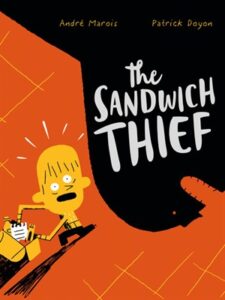 The Sandwich Thief
The Sandwich Thief
By Andre Marois
By Patrick Doyon
Chronicle Books
$14.99
ISBN: 978-1-4521-4659-1
Ages 7-9
On shelves March 1st
Injustice, that sweet universal quality, makes for great children’s books. Whether it’s a picture book or a young adult novel, if you can tap into a reader’s sense of unfairness you have yourself some children’s book gold. It’s the instantaneous gateway to identification. Adults too often forget how painful those early lessons about how the world is an unfair place feel. Children’s books tap into that feeling, while also giving kids a sense of hope. Yes, the world is a mad, bad place sometimes. But there are times when things work out for the best. And if its takes disgusting flavor balls in delicious sandwiches to reach that cathartic ending, so much the better. I wouldn’t argue that Andre Marois’s The Sandwich Thief is the greatest book on this subject I’ve ever seen (it could use a little work in the empathy department), but when it comes to tapping into that feeling of unbridled rage in the face of a cold, calculating world, this title definitely knows its audience.
There are upsides and downsides to having foodies for parents. On the one hand, they can seriously embarrass you when they overdo your school lunches. On the other hand, delicious sandwiches galore! Marin’s a big time fan of his mom’s sandwich constructions, particularly when graced with her homemade mayonnaise, but then one day the unthinkable occurs. Marin goes to take his sandwich to the lunchroom only to find it is gone! When it happens a second time on a second day Marin is convinced that a thief is in his midst. But who could it be? A classmate? A teacher? Everyone is suspect but it’s Marin’s clever mama who knows how to use her mad genius skills to out the culprit, and in a very public way!
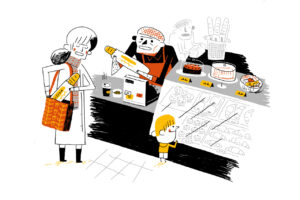 Writing a good early chapter book takes some daring. The form is so incredibly limited. It’s best to have a story that can be read in a single sitting by a parent, or over the course of several attempts by a child just getting used to longer sentences. In this book Marois sets up his mystery with care. There are lots of red herrings, but the author also plays fair, including the true villain amongst the innocuous innocents. The adults made for particularly interesting reading. For example, I loved the portrait of Marin’s principal Mr. Geiger, a man so rumpled and ill-fed you wonder for quite some time how he got his current position (he redeems himself at the end, though).
Writing a good early chapter book takes some daring. The form is so incredibly limited. It’s best to have a story that can be read in a single sitting by a parent, or over the course of several attempts by a child just getting used to longer sentences. In this book Marois sets up his mystery with care. There are lots of red herrings, but the author also plays fair, including the true villain amongst the innocuous innocents. The adults made for particularly interesting reading. For example, I loved the portrait of Marin’s principal Mr. Geiger, a man so rumpled and ill-fed you wonder for quite some time how he got his current position (he redeems himself at the end, though).
I like to tell folks that we are currently in a new Golden Age of children’s literature. This is, admittedly, a fairly ridiculous statement to make since few people can be aware of a Golden Age, even if they are already waist deep in it. Still, the evidence is striking. Never before have authors or illustrators had so much freedom to play around with forms, construction, colors, art styles, etc. It’s not a free-for-all or anything (unless you’re self-publishing) but ideas that publishers might have balked at twenty years ago are almost commonplace today. Take The Sandwich Thief as one such example. Here you have an early chapter book that draws heavily on the classic comic tradition. But speech balloons aside, artist Patrick Doyon makes every single page an eclectic experience. A French-Canadian editorial illustrator who had never made a children’s book prior to this one, in this book Doyon moves effortlessly between two-page spreads, borderless panels, sequential art, the works. You might be so wrapped up in the form that you’d miss how limited his palette is. Working entirely in orange, red, and black, Doyon’s talents are such that you never even notice the missing colors during your reading experience.
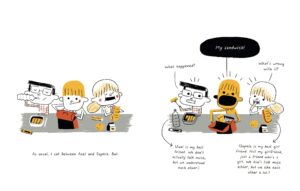 Sadly, there are some aspects to this brand new book that feel like they were written twenty or thirty years ago (and not in a good way). When identifying the potential thieves in his classroom, Marin falls back onto some pretty broad stereotypes. We’re in an era when body acceptance makes old-fashioned fat shaming feel downright archaic. With that in mind, the identification of one student as “Big Bobby” whose “main hobby is eating” is particularly unfortunate. Add in “Poor Marie” whose mom lost her job and can’t afford to eat, and you’ve got yourself an odd avoidance of sympathy. Another reader of this book mentioned that the villains is of a similar lower-socioeconomic level, which is questionable. There are also a couple insults like “Numbnuts” floating about the text that will pass without comment in some households and be a major source of contention in others. FYI.
Sadly, there are some aspects to this brand new book that feel like they were written twenty or thirty years ago (and not in a good way). When identifying the potential thieves in his classroom, Marin falls back onto some pretty broad stereotypes. We’re in an era when body acceptance makes old-fashioned fat shaming feel downright archaic. With that in mind, the identification of one student as “Big Bobby” whose “main hobby is eating” is particularly unfortunate. Add in “Poor Marie” whose mom lost her job and can’t afford to eat, and you’ve got yourself an odd avoidance of sympathy. Another reader of this book mentioned that the villains is of a similar lower-socioeconomic level, which is questionable. There are also a couple insults like “Numbnuts” floating about the text that will pass without comment in some households and be a major source of contention in others. FYI.
Winner of the Governor General’s Literary Award for Illustrated Children’s Literature, French Language, Marois and Doyon’s first collaboration is for any kid that comes in looking for a fun read with a mystery component. With its classy format and striking cover it may even appeal to the Wimpy Kid contingent. Hey, stranger things have happened. It’s a true bummer that the book dumps on so many people along the way but it may still appeal to any kid who craves a little justice in the world. Particularly if that justice comes with the taste of chalk-textured cat pee.
On shelves March 1st.
Source: Final copy sent from publisher for review
Like This? Then Try:
Professional Reviews: Kirkus
Other Jackets:
It can’t really compare to the English language version, but the original French cover is pretty cute too:
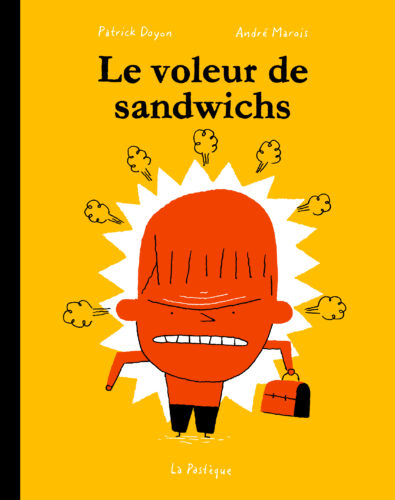


By:
Betsy Bird,
on 1/24/2016
Blog:
A Fuse #8 Production
(
Login to Add to MyJacketFlap)
JacketFlap tags:
macmillan,
Lisa Brown,
Neal Porter Books,
Best Books of 2016,
2016 picture books,
2016 reviews,
Reviews 2016,
Reviews,
Roaring Brook,
Best Books,
picture book reviews,
Add a tag
 The Airport Book
The Airport Book
By Lisa Brown
A Neal Porter Book, Roaring Brook, an imprint of Macmillan
$16.99
ISBN: 978-1-62672-091-6
Ages 4-7
On shelves May 10th.
Look, I don’t wanna brag but I’m what you might call a going-to-the-airport picture book connoisseur. I’ve seen them all. From out-of-date fare like Byron Barton’s Airport to the uniquely clever Flight 1-2-3 by Maria Van Lieshout to the odd but helpful Everything Goes: In the Air by Brian Biggs. Heck, I’ve even examined at length books about the vehicles that drive on the airport tarmac (see: Brian Floca’s Five Trucks). If it helps to give kids a better sense of what flying is like, I’ve seen it, baby. And I will tell you right here and now that not a single one of these books is quite as good at explaining every step of the journey as well as Lisa Brown’s brand new The Airport Book. I’d even go so far as to say that it’s more than just an instructional how-to. Packed with tiny details that make each rereading worthwhile, a plot that sweeps you along, and downright great information, this one here’s a keeper to its core.
“When you go to the airport, you can take a car, a van, a bus, or even a train. Sometimes we take a taxicab.” A family of four prepares for a big trip. Bags are packed with the haste that anyone with small children will recognize. Speed is of the essence. As they arrive at the airport we meet other people and families taking the same flight. There’s airport security to get through (the book mentions the many lines you sometimes have to stand in to get where you’re going), the awesome size of the airport itself, the gate, and then the plane. As we watch the younger sister in the family is having various mild freakouts over her missing (or is it?) stuffed monkey. The monkey in question is always in our view, packed in a suitcase, discovered by a dog during the flight, and finally reuniting with its owner on the luggage carousel. The family meets up with the grandparents and at last the vacation can begin. That is, until they all have to go home again.
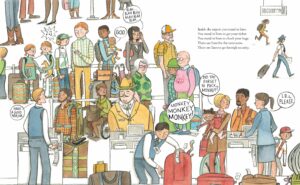 The problem with most airport-related picture books is something I like to call the Fly Away Home conundrum. Originally penned by Eve Bunting, Fly Away Home is one of those rare picture books out there that deal with homelessness in a realistic way. The story features a father and son living out of an airport. Since it touches on such an important, and too little covered, topic, the book continues to appear on required reading lists, in spite of the fact that the very premise is now woefully out-of-date. There are few areas of everyday American life that have changed quite so dramatically over such a short amount of time as the average airport experience. That’s why so many things about The Airport Book rang true for me. When Brown covers the facts surrounding departures and goodbyes to family and friends, she doesn’t set the scene inside the building but rather on the sidewalk outside of ticketing, as people are dropped off. Later you see people at their gate plugging in their cell phones willy-nilly (something I’ve never seen in a picture book before). It lends the book a kind of air of authenticity.
The problem with most airport-related picture books is something I like to call the Fly Away Home conundrum. Originally penned by Eve Bunting, Fly Away Home is one of those rare picture books out there that deal with homelessness in a realistic way. The story features a father and son living out of an airport. Since it touches on such an important, and too little covered, topic, the book continues to appear on required reading lists, in spite of the fact that the very premise is now woefully out-of-date. There are few areas of everyday American life that have changed quite so dramatically over such a short amount of time as the average airport experience. That’s why so many things about The Airport Book rang true for me. When Brown covers the facts surrounding departures and goodbyes to family and friends, she doesn’t set the scene inside the building but rather on the sidewalk outside of ticketing, as people are dropped off. Later you see people at their gate plugging in their cell phones willy-nilly (something I’ve never seen in a picture book before). It lends the book a kind of air of authenticity.
The story’s good and the art’s great but what I liked about the book was the language. Brown never tells you precisely what is going to happen, but she does mention the likelihoods. “Sometimes the plane is bouncy, but most of the time it is smooth.” “Sometimes the sidewalks and staircases move by themselves.” “Sometimes there are small beeping cars driving through . . .” As you read, you realize that in a way the narration of the book is being created for us from the perspective of the big brother. He’ll occasionally insert little notes that are probably of more use to him than us. Example: “You have to hold your little sister’s hands tight, or she could get lost.” Mind you, some of the sections have the ring of poetry to them, while staying squarely within a believable child’s voice. I was particularly fond the of the section that says, “Outside there are clouds and clouds and clouds.”
 With all the calls for more diverse picture books to be published, it would be noticeable if Ms. Brown’s book didn’t have a variety of families, races, ages, genders, etc. What’s notable to me is that she isn’t just checking boxes here. Her diversity far surpasses those books where they’ll throw in the occasional non-white character in a group shot. Instead, the main family has a dark-skinned father and light-skinned, blond mother. Travels through the airport show adults in wheelchairs, twins, women in headscarves, Sikhs, pregnant ladies, and more. In other words, what you’d actually see in an airport these days.
With all the calls for more diverse picture books to be published, it would be noticeable if Ms. Brown’s book didn’t have a variety of families, races, ages, genders, etc. What’s notable to me is that she isn’t just checking boxes here. Her diversity far surpasses those books where they’ll throw in the occasional non-white character in a group shot. Instead, the main family has a dark-skinned father and light-skinned, blond mother. Travels through the airport show adults in wheelchairs, twins, women in headscarves, Sikhs, pregnant ladies, and more. In other words, what you’d actually see in an airport these days.
And then the little details come up. Brown throws into the book a surprising array of tiny look-and-discover elements, suggesting that perhaps this book would be just as much fun in its way as a Where’s Waldo? game for older siblings as it is their younger brethren. Ask them if they can find The Wright Brothers, Hatchet (don’t think too hard about what happens to the plane in that book), the mom’s copy of Jack Kerouac’s On the Road, or the person looking for Amelia Earhart (who may not be as difficult to find as you think). There’s also a cast of characters that command your attention like the businesswoman who’s always on her cell phone and the short artist with the mysteriously shaped package.
There’s nothing to say that in five years airports will be just as different to us today as pre-9/11 airports are now. Yet even if our airports start requiring us to hula hoop and dance the Hurly Burly, Brown’s book is still going to end up being the go-to text desperate parents turn to when they need a book that explains to their children what an average airplane flight looks like. It pretty much gets everything right, exceeding expectations. Generally speaking, books that tell kids about what something is like (be it a trip to the dentist or a new babysitter) are pedantic, didactic, dull as dishwater fare. Brown’s book, in contrast, has flare. Has pep. Has a beat and you can dance to it. Like I said, this may be the best dang going-to-the-airport book I can name (though you should certainly check out the others I’m mentioned at the beginning of this review). A treat, it really is. A treat.
On shelves May 10th.
Source: Galley sent from publisher for review.
Like This? Then Try:
Interviews: Miss Marple’s Musings


By:
Betsy Bird,
on 1/7/2016
Blog:
A Fuse #8 Production
(
Login to Add to MyJacketFlap)
JacketFlap tags:
Reviews,
Best Books,
funny picture books,
Sebastian Meschenmoser,
German children's books,
translated picture books,
NorthSouth Books,
German imports,
Best Books of 2016,
2016 imports,
2016 picture books,
2016 reviews,
Add a tag
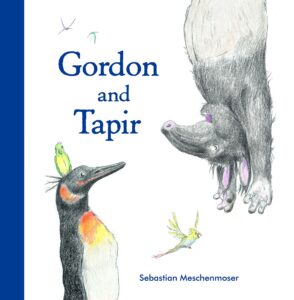 Gordon and Tapir
Gordon and Tapir
By Sebastian Meschenmoser
North/South Books
$18.95
ISBN: 9780735842199
Ages 3-6
On shelves April 1, 2016
There is a perception here in America about the Germans. It is a firm belief that, as a nation, they are devoid of a sense of humor. Americans love to bring this up. I’m not sure what they’re trying to prove necessarily when they say it, but the idea has been repeated so often that few would bother to contest it. Can you name any German stand-up comics? How about funny imported German films? What about funny German picture books? AH HA! There I’ve got you. Because while I cannot pull out of a hat any comics or movies, what I can do is show you without a sliver of a doubt that thanks to picture books like those of Sebastian Meschenmoser, we have absolute proof that Germans have a distinct and ribald sense of humor. With the release of his latest book in the States, Gordon and Tapir, Meschenmoser plumbs the Odd Couple concept with some distinctive twists of his very own. This is some primo German goofball stuff.
The book opens wordlessly. A penguin goes to his restroom with a newspaper. He reaches for the toilet paper. But what is this? Someone’s used it all up. And not just anyone. The penguin, who goes by the name of Gordon, stamps down the hall to his roommate Tapir’s room. Inside he finds the animal reclining in a toilet paper constructed hammock, an elaborate fruit cup in hand and a headdress that would wow Carmen Miranda on his noggin. Immediately Gordon launches into a litany of transgressions Tapir has engaged in. The floor’s sticky with fruit, the dishes are never done, and why exactly has there been a hippo living in the bathtub for the past few days? Tapir isn’t taking this lying down. He has his own complaints, like why does EVERYTHING have to be so neat and tidy? Why does the garbage have to stink of fish all the time? And why can’t Tapir join Gordon’s all-penguin club? Eventually, Gordon moves out and once Tapir discovers this he gives the bird a call. Turns out, it is a fantastic solution. Now Tapir can be dirty, Gordon can be neat, but they can visit each other and be friends again far better than if they lived together. Happy endings for all.
I’ve always carried the torch for Meschenmoser’s art. From his sleepless animals in Waiting for Winter to his previous penguin dip into surrealism in Learning to Fly the man has a strange kinship with the furry and feathery. So much of the character development in these tales comes from their body language. For example, there’s a spread in this book where Gordon lies in bed on his back staring at the ceiling at 3 a.m. while Tapir does much the same thing, albeit blearily, in his own room. This is followed by a silent film of sorts where Gordon finds a new place to stay in the paper and takes off as Tapir hears the door open and looks up with just the saddest expression in his eyes. Any picture book that dares to go silent for an extended amount of time in the center of the story is being gutsy. It’s not easy to pull off, and Meschenmoser ups the ante (as it were) by rendering everything during those wee hours of the morning in black and white graphite sketches.
 Then there are the little visual details and gags. The humor is sublime here. Meschenmoser is just as comfortable with silent gags (remember, this is coming from the man who made Charlie Chaplin references in the images of Mr. Squirrel and the Moon) as he is with words. Some of the jokes are there for the parents doing the reading. Did you notice the tapir in a bathing suit that bedecks the inside bathroom door? Or the fact that when Gordon stomps from the bathroom to Tapir’s room the wallpaper goes from a pristine fish pattern to paper that’s torn and peeling in large chunks? Did you see that the little cactus that Tapir gives to Gordon as a housewarming present is sitting on his dresser earlier in the book? And did you know that every single one of Gordon’s penguin friends is based on a famous author? I’ve good money riding on the fact that one of them resembles Sigmund Freud. I loved that Gordon has a goldfish swimming in his party drink (a tasty treat for later?). And so tiny you’d probably miss them but worth it every time I notice them is this: mongooses in teeny tiny colorful party hats. Life is sweeter because they are there.
Then there are the little visual details and gags. The humor is sublime here. Meschenmoser is just as comfortable with silent gags (remember, this is coming from the man who made Charlie Chaplin references in the images of Mr. Squirrel and the Moon) as he is with words. Some of the jokes are there for the parents doing the reading. Did you notice the tapir in a bathing suit that bedecks the inside bathroom door? Or the fact that when Gordon stomps from the bathroom to Tapir’s room the wallpaper goes from a pristine fish pattern to paper that’s torn and peeling in large chunks? Did you see that the little cactus that Tapir gives to Gordon as a housewarming present is sitting on his dresser earlier in the book? And did you know that every single one of Gordon’s penguin friends is based on a famous author? I’ve good money riding on the fact that one of them resembles Sigmund Freud. I loved that Gordon has a goldfish swimming in his party drink (a tasty treat for later?). And so tiny you’d probably miss them but worth it every time I notice them is this: mongooses in teeny tiny colorful party hats. Life is sweeter because they are there.
But for all that, the real reason I loved this book as much as I did was that the lesson I took away from it wasn’t American in the slightest. Imagine if a Yank tried writing the same book. Gordon and Tapir would have their differences. They’d have their fight. They’d both spend a sleepless night. Then the next morning Gordon would make a concession, Tapir would make a concession, and they’d work out their differences. And there is nothing wrong with a book about meeting someone halfway. Yet what I loved so much about this book was the fact that it eschewed every rote picture book plot I’d come to expect and went in an entirely new direction. Because honestly, let’s face it, sometimes friends are NOT meant to live together. Couples grow apart, people change, and there are times when you are much closer to someone if they don’t share the same space that you do 24/7. Meschenmoser makes it crystal clear that Gordon and Tapir’s friendship is stronger when Gordon leaves. Now I’m sure some folks will read this as a “stick with your own kind” narrative (after all, tapirs and penguins don’t even occupy the same temperate zones) but I’d argue that their friendship belies that. It isn’t that they don’t vastly enjoy each other’s company. They just need their own personal space at the end of the day, and that is absolutely 100% a-okay.
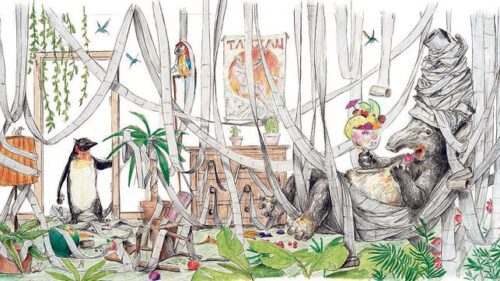 As crazy as it sounds, this actually wouldn’t be the worst picture book to hand to a small child with parents going through a divorce. I think it’s pretty clear from the book that sometimes you have nothing in common with the person you’re living with and that it’s best for all parties if a split is made. I don’t think the book was written with that intention in mind, and that is probably why it would work particularly well. There isn’t any didacticism to plow through. Just good storytelling
As crazy as it sounds, this actually wouldn’t be the worst picture book to hand to a small child with parents going through a divorce. I think it’s pretty clear from the book that sometimes you have nothing in common with the person you’re living with and that it’s best for all parties if a split is made. I don’t think the book was written with that intention in mind, and that is probably why it would work particularly well. There isn’t any didacticism to plow through. Just good storytelling
There’s a long history of funny German children’s literature that leads directly to Mr. Meschenmoser. Remember that this is the country where Der Struwwelpeter came to light (though its humor is a bit of an acquired taste). And alongside fellow contemporary funny German picture book artists like Torben Kuhlmann and Ole Konnecke he’s in good standing. With any luck we’ll be seeing more of their books coming to U.S. shores in the coming years. So who knows? Maybe if we get enough Gordon and Tapir types of books the humorless perception of the German people will undergo a change. At the very least, we’ll get some magnificent stories out of the deal. This one’s a keeper.
On shelves April 1st.
Source: Galley sent from publisher for review.
Like This? Then Try:

 Don’t Call Me Grandma
Don’t Call Me Grandma First and foremost, this is not a fuzzy grandparent (or great-grandparent) book. There are plenty of fuzzy books out there, filled to brimming with warm snuggly feelings. If that is the kind of book you require then grab yourself the nearest Nancy Tillman and content yourself accordingly. What we have here instead is a kind of character study. Whatever expectations you carry into this book, they will be upended by the text. Nell is an amazing character, one that I’ve never seen in book of this sort. Her prickly nature may well hide that “broken heart” she mentions obliquely, but it could just as easily hide more prickles. We get three distinct memories of her past, but it’s a single wordless two-page spread that probably says more about her than anything else. As an adult, I found myself speculating about her life. How perhaps she had dreams of dancing professionally but that she put those dreams aside when she had her children at a very young age. No kid is going to read into Nell what I have. That’s what makes reading this book so dynamic. Come for the prickly relative. Stay for the enticing, unknowable back story.
First and foremost, this is not a fuzzy grandparent (or great-grandparent) book. There are plenty of fuzzy books out there, filled to brimming with warm snuggly feelings. If that is the kind of book you require then grab yourself the nearest Nancy Tillman and content yourself accordingly. What we have here instead is a kind of character study. Whatever expectations you carry into this book, they will be upended by the text. Nell is an amazing character, one that I’ve never seen in book of this sort. Her prickly nature may well hide that “broken heart” she mentions obliquely, but it could just as easily hide more prickles. We get three distinct memories of her past, but it’s a single wordless two-page spread that probably says more about her than anything else. As an adult, I found myself speculating about her life. How perhaps she had dreams of dancing professionally but that she put those dreams aside when she had her children at a very young age. No kid is going to read into Nell what I have. That’s what makes reading this book so dynamic. Come for the prickly relative. Stay for the enticing, unknowable back story. The child in this book is much like the child who will be reading it with an adult. Both she and they sense that there is more at work here than meets the eye. And it is the art by Elizabeth Zunon that backs that feeling up. Elizabeth Zunon has been a force to reckon with for years. I first noticed her when she illustrated William Kamkwamba’s The Boy Who Harnessed the Wind, though I unknowingly had already been a fan of hers when she illustrated Jeanne Harvey’s My Hands Sing the Blues. In Don’t Call Me Grandma she begins with a straightforward contemporary story. Even then, her endpapers start telling the tale long before the words do (not counting the title). She fills these early pages with strings of pearls. Fat pearls, small pearls, pink and gray and white pearls. Note that in the text there is just one mention of those pearls, and it’s in the context of a lot of other things on Nell’s dressing table. But Zunon is getting a grip on her personality in her own way. Because of her we get a distinct sense of Great-Grandmother’s style, poise, and dignity. There are fun little details too, like the family peering out through the window as Nell gives a singing bird what for and how to. Zunon also lends Nell a humanity on the sidelines. When her great-granddaughter looks around her room we see Nell observing affectionately from the sides (though she’d be the first to deny it if you accosted her with the evidence). Then there are the memories. Depicted as splotchy watercolors, Zunon subtly changes her style to indicate how some memories are crystal clear even as they blur and go soft around the edges. The two-page spread of objects representing other memories (everything from photographs of Civil Rights marchers to tickets to an Alvin Ailey ballet) will require giving child readers some context. Nothing wrong with that. Sit them down and explain each thing you see. Don’t recognize something? Look it up!
The child in this book is much like the child who will be reading it with an adult. Both she and they sense that there is more at work here than meets the eye. And it is the art by Elizabeth Zunon that backs that feeling up. Elizabeth Zunon has been a force to reckon with for years. I first noticed her when she illustrated William Kamkwamba’s The Boy Who Harnessed the Wind, though I unknowingly had already been a fan of hers when she illustrated Jeanne Harvey’s My Hands Sing the Blues. In Don’t Call Me Grandma she begins with a straightforward contemporary story. Even then, her endpapers start telling the tale long before the words do (not counting the title). She fills these early pages with strings of pearls. Fat pearls, small pearls, pink and gray and white pearls. Note that in the text there is just one mention of those pearls, and it’s in the context of a lot of other things on Nell’s dressing table. But Zunon is getting a grip on her personality in her own way. Because of her we get a distinct sense of Great-Grandmother’s style, poise, and dignity. There are fun little details too, like the family peering out through the window as Nell gives a singing bird what for and how to. Zunon also lends Nell a humanity on the sidelines. When her great-granddaughter looks around her room we see Nell observing affectionately from the sides (though she’d be the first to deny it if you accosted her with the evidence). Then there are the memories. Depicted as splotchy watercolors, Zunon subtly changes her style to indicate how some memories are crystal clear even as they blur and go soft around the edges. The two-page spread of objects representing other memories (everything from photographs of Civil Rights marchers to tickets to an Alvin Ailey ballet) will require giving child readers some context. Nothing wrong with that. Sit them down and explain each thing you see. Don’t recognize something? Look it up!























I’m starting a campaign: Zunon for 2017 Caldecott.
I also loved Elizabeth’s art for One Plastic Bag by Miranda Paul.
This was definitely an intriguing picture book, with a pleasing repetitive structure always beginning with Great Grandmother Nell is … I also loved the circular structure to the story. It begins with her being scary, and ends with her still being scary and yet we’ve grown, as the narrator has to appreciate her prickliness and spunk as we see their developing bond through the sensory details that are presented.
My grandmother’s dressing table, with its powder puffs and perfumes and little pots of rouge, and her dresser with photos of people wearing enigmatic smiles! This brings it all back (tho I wasn’t afraid of my Grandma, only of her creepy fox marten stole).